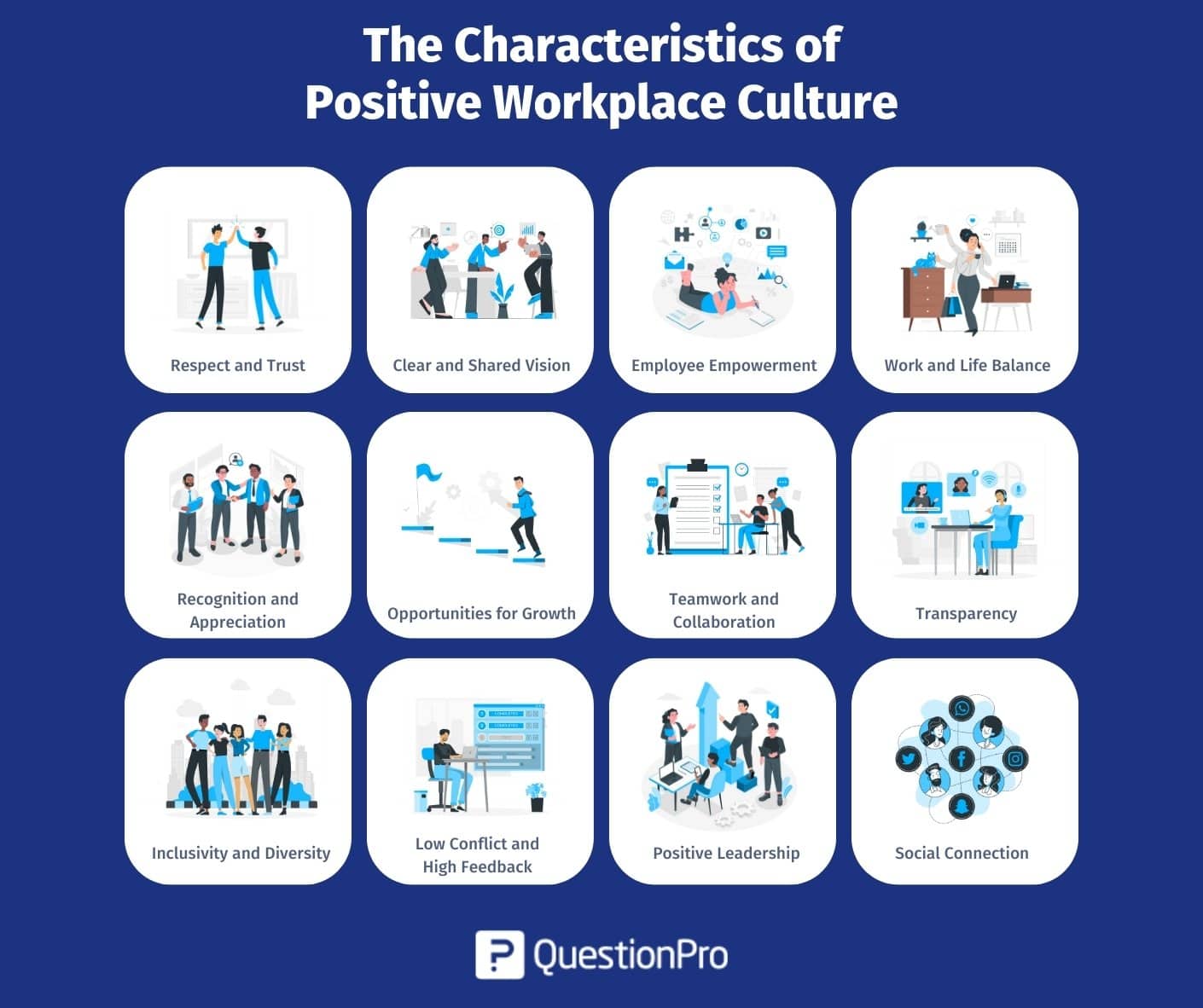
According to a recent survey conducted by Deloitte, 94% of executives and 88% of employees are of the opinion that distinct positive work culture is necessary for business success. For any organization, big or small, workplace culture is very important as it defines the organization. Beliefs, behaviors, attitudes, and principles define an organization’s culture.
In the contemporary business landscape, workplace culture has become an influential factor that significantly shapes an organization’s success, employee satisfaction, and overall performance. It refers to the collective values, beliefs, behaviors, and attitudes shared among employees within a company.
LEARN ABOUT: Employee Trust
A positive and thriving workplace culture fosters employee engagement and productivity, attracts top talent, and enhances an organization’s reputation.
In this blog, we will explore the intricacies of workplace culture, its impact on organizational culture and success, and why it should be a central focus for businesses of all sizes.
What is a workplace culture?
Workplace culture refers to the shared values, beliefs, attitudes, and behaviors that characterize an organization and its employees. It is the collective personality of a company, shaping the overall work environment and influencing how employees interact with one another, with clients or customers, and with their work tasks.
Workplace culture is not tangible but rather intangible elements that form the organization’s fabric. It is often described as the “way things are done around here.” Every organization, consciously created or not, has its unique culture that can greatly impact its success, employee satisfaction, and overall performance.
A toxic workplace culture is characterized by negative attitudes, behaviors, and practices that harm employees’ well-being, hinder productivity, and negatively impact the organization as a whole. In a toxic culture, employees may experience stress, fear, and unhappiness due to harmful dynamics within the organization. That’s Why a healthy culture in the workplace is so important.
Why is workplace culture so important?
Workplace culture is important in a company’s values, success, and overall well-being. Workplace culture is critically important because it significantly influences an organization’s overall functioning, productivity, and success. Here are some key reasons why workplace culture holds such significance:
1. Employee engagement
A positive work culture fosters higher levels of employee engagement. Employees who feel connected, valued, and supported are more likely to be motivated and committed to their work. Engaged employees are more productive, creative, and less likely to leave the organization.
2. Retention and recruitment
A strong workplace culture helps attract and retain top talent. In a competitive job market, job seekers often prioritize organizations with a reputation for a healthy workplace environment and positive cultures. Employees are more likely to stay with a company that aligns with their values and offers a fulfilling work experience.
3. Performance and productivity
A positive culture promotes collaboration, teamwork, and open communication. An employee feels comfortable sharing ideas, seeking help, and providing constructive feedback. As a result, productivity and performance levels tend to be higher in such environments.
4. Innovation and creativity
A culture that encourages innovation and risk-taking fosters creativity among employees. When employees are not afraid to experiment or voice new ideas, it can lead to breakthrough innovations and process improvements.
5. Employee well-being
A supportive workplace culture contributes to the well-being of employees. When organizations prioritize work-life balance, mental health support, and a healthy work environment, employees experience lower stress levels and burnout.
6. Customer satisfaction
Happy and engaged employees are more likely to provide better customer service. A positive work culture translates to better interactions with customers, leading to increased customer satisfaction and loyalty.
7. Organizational reputation
Workplace culture influences the organization’s internal and external reputation. Create a positive culture that enhances the company’s image, attracting partners, clients, and investors who want to be associated with a reputable and responsible organization.
8. Conflict resolution
A healthy workplace culture encourages open dialogue and constructive conflict resolution. Employees feel comfortable addressing issues when they arise, preventing conflicts from escalating and creating a toxic work environment.
9. Adaptability and resilience
A strong workplace culture instills a sense of purpose and shared values among employees. This shared identity helps the organization adapt to change, overcome challenges, and stay resilient during difficult times.
10. Legal and ethical compliance
A positive culture can lead to better ethical behavior and compliance with regulations. Employees are more likely to follow positive company culture, policies and adhere to ethical standards when they believe in the organization’s values and its commitment to integrity.
Key elements of workplace culture
Workplace culture is a complex and multifaceted concept, but it can be understood through several key elements that shape the environment and behaviors within an organization. Here are some essential elements of workplace culture:
- Values and beliefs: An organization’s core values and beliefs are fundamental to its culture. These guiding principles influence decision-making, actions, and interactions among employees.
- Mission and purpose: A clear and compelling mission or purpose provides employees with a sense of direction and meaning in their work. Employees who understand the organization’s broader goals are more likely to be motivated and aligned with its mission.
- Norms and behaviors: Workplace culture is defined by the norms and behaviors that are accepted and expected within the organization. This includes how employees communicate, collaborate, handle conflicts, and treat one another.
- Leadership style: Leadership plays a significant role in shaping workplace culture. Leaders set the tone, lead by example, and influence the values and behaviors that are prioritized within the organization.
- Communication: Open and transparent communication is crucial for a healthy workplace culture. When communication flows freely between employees and leadership, it fosters trust, reduces misunderstandings, and encourages engagement.
- Recognition and reward: A culture that recognizes and rewards employees for their contributions and achievements creates a positive and motivating work environment. Recognition can be both formal, like awards or bonuses, and informal, such as a simple word of appreciation.
LEARN ABOUT: Employee Rewards Ideas for Employee Engagement
- Inclusivity and diversity: A culture that values diversity and promotes inclusivity is essential for creating a welcoming and respectful workplace. Embracing diverse perspectives can lead to increased creativity, innovation, and a broader understanding of the customer base.
- Learning and development: A culture that emphasizes learning and development shows a commitment to employees’ growth. Organizations that invest in their employees’ skill development and professional advancement tend to have higher engagement and job satisfaction levels.
- Work-life balance: A culture that supports work-life balance acknowledges the importance of employees’ personal lives and well-being. Flexibility in work arrangements and understanding the importance of time off contribute to a healthier work environment.
- Ethics and integrity: Workplace culture should prioritize ethical behavior and integrity. Organizations that maintain high ethical standards gain trust from employees, customers, and the public.
- Respect and trust: Respectful and trusting relationships between colleagues and between employees and management are crucial for a positive culture. A culture of trust fosters collaboration and encourages employees to take calculated risks.
- Adaptability: A culture that embraces change and encourages adaptability is essential in today’s rapidly evolving business landscape. Being open to new ideas and innovation enables organizations to stay relevant and competitive.
The characteristics of a positive workplace culture
A positive workplace culture is characterized by a set of shared values, attitudes, and behaviors that create a supportive and engaging environment for employees. It fosters a sense of belonging, collaboration, and overall well-being. Here are some key characteristics of a positive workplace culture:

1. Respect and trust
Employees feel respected and trusted by their colleagues and managers. This means there is open communication, active listening, and appreciation for diverse perspectives and opinions.
The organization has a clear vision and mission that is communicated to all employees. Everyone understands how their role contributes to the company’s overall goals, which creates a sense of purpose.
3. Employee empowerment
Employees are empowered to make decisions and take ownership of their work. They have the authority and resources necessary to accomplish their tasks effectively.
4. Work and life balance
The company culture acknowledges the importance of work and life balance and promotes practices that support employees’ well-being. This may include flexible working hours, remote work options, or wellness programs.
LEARN ABOUT: Employee Wellness
5. Recognition and appreciation
Employees’ efforts and achievements are regularly recognized and appreciated. Acknowledgment can be formal through rewards and informal through genuine gratitude.
6. Opportunities for growth
A positive workplace culture provides opportunities for professional and personal growth. This may include training programs, career development, and mentorship.
7. Teamwork and collaboration
The culture encourages teamwork and collaboration. Employees are encouraged to work together, share ideas, and support each other to achieve common goals.
8. Transparency
There is transparency in communication and decision-making processes. Employees feel informed about important matters and understand how decisions are made.
9. Inclusivity and diversity
The culture embraces diversity and fosters an inclusive environment where all employees are valued, respected, and included.
10. Low conflict and high feedback
A positive culture addresses conflicts constructively and encourages open feedback culture. Employees somehow feel safe to express their concerns and offer suggestions for improvement.
11. Positive leadership
Leaders set the tone for workplace cultures. Positive leadership involves leading by example, being approachable, and motivating employees to perform at their best.
12. Social connection
The workplace fosters social connections among employees. This can be through team-building activities, social events, or simply creating spaces for casual interactions.
By cultivating these characteristics, organizations can create a positive culture that attracts and retains talent and fosters a productive and happy workforce.
Examples of successful, positive workplace cultures
Workplace culture is everywhere. They exist in the world’s largest firms and remain in smaller ones. Here is one example of an inspiring workplace culture. Several companies are known for their successful and positive workplace cultures. Here are some examples:
Google
Google is renowned for its positive workplace culture that emphasizes creativity, innovation, and employee well-being. The company and company culture offers various perks like gourmet meals, on-site gyms, and flexible work schedules. Employees are encouraged to spend a portion of their time on personal projects, fostering a culture of autonomy and creativity.
Microsoft
Over the years, Microsoft has transformed its culture to become more inclusive and supportive. The company culture values diversity and inclusion and actively promotes initiatives to foster a sense of belonging among its employees. Microsoft also emphasizes continuous learning and professional development.
Airbnb
A sense of community and inclusivity characterizes Airbnb’s culture. The company fosters a culture of trust, where employees are encouraged to take risks and learn from their mistakes. They also have a strong commitment to diversity and belonging.
Netflix
Netflix is known for its unique and high-performance culture. The company emphasizes a culture of freedom and responsibility, where employees are given significant autonomy and trust to make decisions. They prioritize talent and reward excellence, which has contributed to their success as a streaming giant.
Apple
Apple has a strong culture of innovation and creativity. The company culture encourages its employees to think differently and take risks to push the boundaries of technology. Apple’s collaborative and design-focused culture has led to the development of groundbreaking products.
Conclusion
Workplace culture is a powerful force that shapes an organization’s success and its employees’ experiences. A positive workplace culture enhances employee engagement, productivity, and well-being while attracting and retaining top talent. It fosters collaboration, creativity, and a sense of purpose, leading to improved innovation and customer satisfaction.
Investing in building and maintaining a positive workplace culture is not just a nice-to-have but a must-have for any organization aspiring to thrive in today’s dynamic business environment. By nurturing a culture of respect, support, and growth, organizations can reap the numerous benefits of a truly vibrant and successful workplace culture.
Building the right workplace culture is a big responsibility; everybody in the organization owns it.
If you’re interested in learning more about how QuestionPro’s Workforce tools help organizations manage their workplace cultures, connect with one of our experts. You can also sign up and get a feel of the platform.







